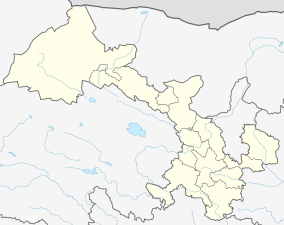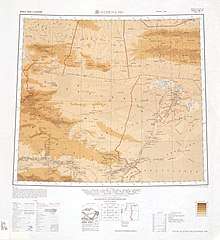Subei Mongol Autonomous County
The Subei Mongol Autonomous County (simplified Chinese: 肃北蒙古族自治县; traditional Chinese: 肅北蒙古族自治縣; pinyin: Sùběi Měnggǔzú Zìzhìxiàn; Mongolian: ᠰᠤᠪᠧᠢ ᠶᠢᠨ ᠮᠣᠩᠭᠣᠯ ᠥᠪᠡᠷᠲᠡᠭᠡᠨ ᠵᠠᠰᠠᠬᠤ ᠰᠢᠶᠠᠨ) is an autonomous county within the prefecture-level city of Jiuquan in the northwest of Gansu Province, China, bordering Xinjiang to the west, Qinghai Province to the southeast and Mongolia's Govi-Altai Province to the north. Containing the northernmost point in Gansu, Subei is split into two non-contiguous sections and has an area of 66,748 km2 (25,772 sq mi) and had approximately 13,046 inhabitants in 2000. To the east it shares a border with Ejin Banner, Alxa League, Inner Mongolia.
Subei Mongol Autonomous County ᠰᠤᠪᠧᠢ ᠶᠢᠨ ᠮᠣᠩᠭᠣᠯ ᠥᠪᠡᠷᠲᠡᠭᠡᠨ ᠵᠠᠰᠠᠬᠤ ᠰᠢᠶᠠᠨ 肃北蒙古族自治县 Su-pei | |
|---|---|
| Subei Mongol Autonomous County 肃北蒙古族自治县 | |
 The Qilian Mountains in Subei County | |
.png) Subei County (red) within Jiuquan City (yellow) and Gansu | |
 Subei Location of the seat in Gansu | |
| Coordinates (Subei government): 39°30′45″N 94°52′36″E | |
| Country | People's Republic of China |
| Province | Gansu |
| Prefecture-level city | Jiuquan |
| Established date | July 29, 1950 |
| Township-level Divisions | 2 towns, 2 townships |
| Area | |
| • Total | 69,300 km2 (26,800 sq mi) |
| Population (2010)[2] | |
| • Total | 14,979 |
| • Density | 0.22/km2 (0.56/sq mi) |
| Time zone | UTC+8 (China Standard) |
| Postal code | 736300 |
| License plate prefixes | 甘F |
| Website | www |
History
In the early 1930s, Birger Bohlin studied the paleontology of the region (then called Taban Buluk).[3]
In 1937, Subei Shezhiju (肅北設治局) was established.[1]
On July 22, 1950, PLA forces entered the Subei area. The Subei Autonomous District (肅北自治區(縣級)), predecessor of the Subei Mongol Autonomous County, was established on July 29, 1950. The area became Subei Mongol Autonomous District (肃北蒙古族自治区(县级)) in 1953. In 1955, the area became Subei Mongol Autonomous County.[1][2]
In September 1992, with the approval of the State Council of the People's Republic of China, the only international border crossing in Gansu Province was opened in the Mazongshan area of Subei Mongol Autonomous County.[1]
Horse shows and races are held periodically in the county.[4][5][6]
Climate
A large part of Subei is in the Gobi Desert. The county has been subject to large dust storms with noted incidents in May 2011[7] and June 2016.[8] There are glaciers in some parts of the county.[9]
Administrative divisions
Subei's administrative seat ("capital") is the town of Dangchengwan (党城湾镇). The county includes two townships, Shibaocheng (石包城乡) and Yanchiwan (盐池湾乡) and one other town to the north separated from the rest of the county, Mazongshan (马鬃山镇) named for Mazong Mountain.[10][1][11][2]
Former administrative divisions in the county include the townships Biegai (别盖乡), Dangcheng (党城乡), Yu'erhong (鱼儿红乡) and Mingshui (明水乡).[2]
Demographics
| Year | Pop. | ±% p.a. |
|---|---|---|
| 2000 | 13,046 | — |
| 2010 | 14,979 | +1.39% |
| [2] | ||
Subei is home to Deed Mongols (Upper Mongols) who migrated to the area.[12] In 1996, the Mongol ethnicity population was 37.5% of the county's total population.[2]
| Nationality | Population (2000) | Percentage |
|---|---|---|
| Han | 8,566 | 65.66% |
| Mongol | 4,112 | 31.52% |
| Tibetan | 209 | 1.60% |
| Hui | 86 | 0.66% |
| Tu | 41 | 0.31% |
| Yugur | 15 | 0.12% |
| Manchu | 7 | 005% |
| Others | 10 | 0.08% |
Gallery
 Map including northern Subei County area (1954)
Map including northern Subei County area (1954) Map including part of the modern Subei Mongol Autonomous County area (1935)
Map including part of the modern Subei Mongol Autonomous County area (1935)
References
- 肃北简介. 肃北蒙古族自治县人民政府 (in Chinese). Retrieved 24 October 2019.
肃北蒙古族自治县位于甘肃省河西走廊西段的南北两侧,周边与1个国家,3个省区,8个县市接壤,是一个以蒙古族为主体的少数民族自治县,也是甘肃省唯一的边境县。全县总面积6.93万平方公里,约占甘肃省总面积的14%,总人口1.18万人,辖2镇2乡26个村委会,是甘肃省人均 占有面积最大的县份之一。{...}民国25年(即1937年)设肃北设置局,1950年7月22日解放,7月29日正式建立肃北蒙古族自治县。{...}肃北县北部马鬃山地区与蒙古国接壤,1992年9月,经国务院批准,开通了甘肃省唯一的边境对外贸易口岸,成为省、市、县对外贸易的窗口。
- 肃北蒙古族自治县历史沿革 [Subei Mongol Autonomous County Historical Development] (in Chinese). XZQH.org. 27 June 2016. Retrieved 24 October 2019.
1950年7月29日建立肃北自治区(县级),1953年改肃北蒙古族自治区(县级),1955年改为肃北蒙古族自治县。{...}1996年,肃北蒙古族自治县面积6.6万平方千米,人口1.1万人,其中蒙古族占37.5%。辖2个镇、6个乡:党城湾镇、马鬃山镇、石包城乡、盐池湾乡、别盖乡、党城乡、鱼儿红乡、明水乡。{...}2000年第五次人口普查,全县常住总人口13046人,其中,党城湾镇4573人,马鬃山镇2789人,党城乡2752人,别盖乡696人,石包城乡1035人,盐池湾乡515人,鱼儿红乡248人,鱼儿红牧场438人。{...}2010年第六次人口普查,肃北蒙古族自治县常住总人口14979人,其中,党城湾镇9792人,马鬃山镇3610人,石包城乡1577人。 2013年,恢复盐池湾乡。
- Stuart Gilder, Yan Chen, Sevket Sen (29 August 2006). "Oligo-Miocene magnetostratigraphy and rock magnetism of the Xishuigou section, Subei (Gansu Province, western China) and implications for shallow inclinations in central Asia". HAL-INSU. p. 4. Retrieved 25 October 2019.
In the early 1930s, Bohlin [1937, 1942] studied the paleontology of the Subei region (then called Taban Buluk).
CS1 maint: multiple names: authors list (link) - Zheng Limin (9 September 2017). "The first Silk Road Nadam Fair opens in Subei County, China". China Central Television. Retrieved 25 October 2019.
During the three day event, 14 activities will be held, including the “Glamorous Subei”photo exhibition, horse-head fiddle concert, costume contest, horse racing, camel racing, archery, wrestling and so on. The festival focuses on the “Belt and Road” construction and the promotion of the colorful nomadic culture on the grassland. Meanwhile, it aims to build a series of cultural tourism brands such as “Sacred Qilian Mountain, Beautiful Subei County”, so as to inject vitality into the development of Subei.
- Owen Fishwick and Li Xiaoxu (6 September 2016). "The warrior spirit enlivens the plains in Gansu". Gansu province official website, China Daily. Retrieved 25 October 2019.
In more recent times, people from a range of ethnicities, including Mongol, Kazakh and Han attend the Nadam Festival held in the Mongolian autonomous county of Subei in Gansu. The event begins each year between July and August in the solar calendar.
CS1 maint: uses authors parameter (link) - "Stunning horse show in Gansu". China News Service. 29 August 2019. Retrieved 25 October 2019.
A horse rider shows a stunt during an equestrian performance in Subei Mongol Autonomous County, Northwest China’s Gansu Province. The riders from a local club made all kinds of moves on the running horses, such as standing on two horses in racing ahead. (Photo: China News Service/Yang Fan)
- 董开炜 (22 May 2011). 周婉婷 (ed.). 敦煌肃北昨现沙尘暴. People's Daily (in Chinese). Retrieved 25 October 2019.
5月21日晚,肃北、敦煌风沙弥漫,气象部门随即发布沙尘暴黄色预警信息。沙尘暴抵达肃北县的时间是当日19时06分,风速8-9米/秒,最大能见度800米。
- 董开炜 (25 June 2016). 杨晨雨 (ed.). 肃北、阿克塞昨遭大风沙尘暴袭击. Gansu Daily 甘肃日报 (in Chinese). Retrieved 25 October 2019.
当日早8时,肃北县城天昏地暗,尘土弥漫,能见度较低,上班的人们纷纷戴着口罩、裹着头巾出门,过往车辆全都亮起警示灯缓慢行进。当日,沙尘天气侵袭国道215线,交通受到影响。据当地气象部门预报,肃北6月24日风速达到18.4米每秒,最小能见度585米,持续了大概2小时。沙尘暴约当日6时结束,后转为浮尘天气,能见度也缓慢上升。据了解,6月份出现沙尘暴在肃北较为罕见。
- "Glacier scenery in Subei Mongolian Autonomous County, NW China's Gansu". Xinhua News Agency. 21 August 2018. Retrieved 25 October 2019.
Photo taken on Aug. 20, 2018 shows the scenery of a glacier in Subei Mongolian Autonomous County, northwest China's Gansu Province. (Xinhua/Fan Peishen)
- 全国行政区划代码 (in Chinese). Shanxi Economic Census Office.Archived 2011-07-07 at the Wayback Machine. Original download page: Archived 2011-07-07 at the Wayback Machine. Published November 2008, accessed 2011-03-03.
- 2018年统计用区划代码和城乡划分代码:肃北蒙古族自治县 [2018 Statistical Area Numbers and Rural-Urban Area Numbers: Subei Mongol Autonomous County] (in Chinese). National Bureau of Statistics of the People's Republic of China. 2018. Retrieved 24 October 2019.
统计用区划代码 名称 620923100000 党城湾镇 620923101000 马鬃山镇 620923201000 盐池湾乡 620923202000 石包城乡
- Mátyás Balog (2013). "Review: Mongolian Language Scholarship on the Mongols of the Gansu-Qinghai Region". Asian Highlands Perspectives: 320 – via Internet Archive.
The Mongols in Qinghai and Gansu provinces are most often referred to as Deed Mongols 'Upper Mongols' or Hoshuud, though Güüshi Han's army also included some Torguud, Hoid (a minor tribe), and Choros troops. After a couple of decades in the region west of Kuku-Nor, some Deed Mongols migrated northwards to Dunhuang in Gansu Province, and their descendants currently live there in Subei Mongol Autonomous County.
External links
| Wikimedia Commons has media related to Subei. |
- 《中华民族》 大美肃北 第一集 净土:随善良质朴肃北人民 赏净土山水草原大美风光 20190819 | CCTV ('The Chinese People- Majestic Subei Part One: Pure Land: Enjoying the Mountains, Waters, Grasslands and Beautiful Scenery of the Pure Land with the Warm-hearted and Plain Folk of Subei Aug 19 2019 CCTV') (in Chinese)
